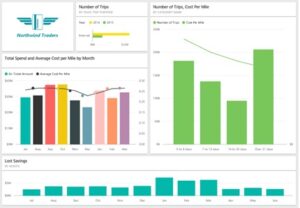Description:
The main purpose of the course is to give students a good understanding of data analysis with Power BI. The course includes creating visualizations, the Power BI Service, and sharing dashboards.
Duration: 3 Days
5 Top Takeaways from the Course

- Make your existing data work harder for you
- Integrate diverse data stores to a single data model
- Transform raw data to business intelligence
- Create rich visualisation from raw data
- Share business intelligence with colleagues
At Course Completion:
After completing this course, students will be able to:
- Perform Power BI desktop data transformation.
- Describe Power BI desktop modelling.
- Create a Power BI desktop visualization.
- Implement the Power BI service.
- Describe how to connect to Excel
- Describe how to collaborate with Power BI data.
- Connect directly to Azure data stores.
- Download and use the Power BI mobile
Audience Profile:
The course will likely be attended by SQL Server report creators who are interested in alternative methods of presenting data.
Prerequisites:
- Excellent knowledge of relational databases and reporting.
- Some basic knowledge of data warehouse schema topology (including star and snowflake schemas).
- Some exposure to basic programming constructs (such as looping and branching).
- An awareness of key business priorities such as revenue, profitability, and financial accounting is desirable.
- Familiarity with Microsoft Office applications – particularly Excel.
Topics:
Module 1: Power BI Desktop Data Transformations
This module describes how to import data into Power BI.
Lessons
- What is Power BI?
- Power BI data
- Transformations
Lab: Import Data to Power BI
- Import data to Power BI desktop
- Import data from CSV files
- Import data from a less structured file
After completing this module, students will be able to:
- Describe what Power BI is and what it does.
- Describe the types of data.
- Perform data transformations.
Module 2: Power BI Desktop Modelling
This module introduces Power BI desktop modelling.
Lessons
- Optimizing data models
- Calculations
- Hierarchies
Lab : Manage Power BI data
- Manage table relationships.
- Last year comparison
- Year to date
- Market share
- Optimize the data model
After completing this module, students will be able to:
- Optimize data models.
- Perform calculations with Power BI data.
- Describe and create hierarchies.
Module 3: Power BI Desktop Visualization
At the end of this module students will be able to create a Power BI desktop visualization.
Lessons
- Visualizing your data
- Working with multiple visualizations
Lab : Create reports with visualizations
- Cross-tabular reports
- Part-to-Whole reports
- Relationship reports
- Trend reports
- Rank reports
After completing this module, students will be able to:
- Visualize data using Power BI
- Work with multiple visualizations.
Module 4: Power BI Service
This module describes how to implement the Power BI service.
Lessons
- Working with the Power BI service
- Configuring a dashboard
- Viewing a Power BI Dashboard
Lab : Implementing the Power BI service
- Upload a Power BI report
- Share a Power BI dashboard
- Configure data refresh
After completing this module, students will be able to:
- Work with the Power BI service.
- Configure a Power BI dashboard.
- View a Power BI dashboard.
